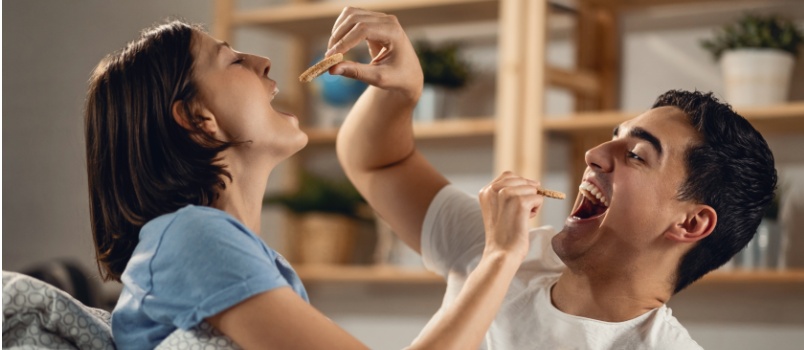Snaccident: Cravings, Relationship Challenges and How to Cope

Unlock Daily 30-Sec Tips for a Happier Relationship
👉 Subscribe FREEKey Takeaways
Marriage.com AI Quick Summary
It starts innocently enough — you grab a handful of chips while scrolling on your phone. The next thing you know, the bag is empty, and you’re not even sure when the last bite happened. You weren’t really hungry… but it felt good in the moment.
Well! You’re not alone.
Research from the American Psychological Association shows that 38% of adults admit to overeating or eating unhealthy foods in response to stress.
Scientists have discussed how these “snaccidents” aren’t just about food — they’re about emotions, habits, and the ways we cope when life feels overwhelming.
And here’s where it gets interesting: the same emotional triggers that send you to the snack cupboard can also show up in your romantic relationships.
Whether it’s seeking comfort, avoiding discomfort, or craving that quick dopamine rush, your relationship with food may be telling you more about your relationship with love than you realize.
What is a snaccident and what does it reveal about you?
A snaccident is what happens when you eat far more than you intended—usually snacks—without really planning or thinking about it. The snaccident definition is simple: it’s an unplanned, often mindless eating episode that leaves you wondering, “How did I just finish that entire bag?”
While the snaccident meaning sounds lighthearted, the behavior often has deeper roots. More often than not, snaccidents aren’t about physical hunger—they’re about emotions. Stress, boredom, loneliness, or even relationship tension can trigger the urge to reach for comfort food.
Experiencing frequent snaccidents can be a snaccident sign that you’re using food as an emotional coping tool. It might signal a need for comfort, distraction, or instant gratification—needs that sometimes mirror how we respond to emotional triggers in our romantic relationships.
This isn’t about guilt—it’s about noticing the “why” behind your habits and understanding what they might be telling you about your emotional needs.
Recognizing this connection is the first step toward making more intentional choices, both at the table and in love.
How does your relationship with food mirror your romantic relationships?
We often think of eating habits and relationship habits as completely separate — but the way you approach food can reveal surprising similarities to the way you handle love. Both can involve comfort-seeking, quick rewards, or patterns of avoidance.
Research published in Eating Behaviors (2013) found that emotional eating often shares psychological pathways with attachment styles in relationships.
People with insecure attachment — whether anxious or avoidant — are more likely to use food as an emotional regulator, similar to how they seek or withdraw from intimacy.
Here are some parallels between food and love relationships:
| Food Relationship Pattern | Love Relationship Pattern |
|---|---|
| Comfort-seeking: Turning to favorite snacks when stressed or lonely. Example: Eating ice cream after a long, difficult day. | Seeking physical affection, reassurance, or validation from a partner during stress. Example: Needing extra attention after a work setback. |
| Instant gratification: Choosing quick, satisfying foods over healthier but slower options. Example: Grabbing chips instead of cooking. | Rushing into relationships or seeking immediate emotional highs rather than building slowly. Example: Jumping into intense romance after just a few dates. |
| Avoidance: Using food to distract from uncomfortable feelings or situations. Example: Snacking to avoid thinking about an argument. | Pulling away from emotional conversations or avoiding difficult topics with a partner. Example: Changing the subject during conflict. |
| Reward rituals: Associating treats with celebrations or milestones. Example: Indulging in dessert after a promotion. | Using romantic gestures or date nights as rewards rather than ongoing connection. Example: Planning special evenings only after big achievements. |
| Dependency cycles: Relying on certain foods to regulate mood or feel “okay.” Example: Daily need for sugary snacks to lift mood. | Relying heavily on a partner to manage emotions or self-esteem. Example: Feeling lost or low without their constant reassurance. |
When you look closely, the overlap is clear — both food and love can be sources of comfort, distraction, celebration, and even dependence.
The good news? Building awareness and healthier patterns in one area often strengthens the other. If you can learn to manage cravings and emotional triggers with food, you’re also building the skills to create more balanced, resilient romantic relationships.
5 common relationship-linked triggers behind snaccidents
Snaccidents often happen when emotions run high — and relationships can be one of the biggest emotional influences in our lives. These triggers aren’t just about food; they’re about how we cope, connect, and sometimes avoid what’s really going on.
1. Conflict or emotional tension
Arguments, passive-aggressive remarks, or ongoing disagreements can leave you feeling unsettled. For many people, food becomes a quick, reliable form of comfort — something they can control when the relationship feels unpredictable.
The act of eating distracts from the discomfort and provides a short-term emotional “reset,” even if it doesn’t solve the problem.
Example: After a heated discussion about weekend plans, you head to the kitchen and mindlessly snack while replaying the conversation in your head — focusing on the crunch instead of the conflict.
2. Loneliness or emotional distance
Feeling alone doesn’t always mean being single — you can feel lonely even when you’re with someone if there’s a lack of emotional closeness.
Food, especially comfort foods tied to positive memories, can temporarily fill that emotional gap. The act of eating can feel like self-soothing when your partner feels unavailable or distant.
Example: Your partner spends the evening on their phone or working late, and instead of initiating connection, you settle in with a favorite snack and Netflix — filling the quiet with food instead of conversation.
3. Celebrations and “treat culture”
Couples often bond over food-related celebrations — from date night desserts to holiday feasts. While occasional indulgence is part of life, treating every milestone (or minor event) with rich or sugary food can lead to snaccidents becoming routine.
Over time, the emotional “reward” becomes tied to food instead of the shared experience itself.
Example: You and your partner get through a busy week, and without fail, you order a big pizza and dessert “because we deserve it,” even if neither of you is actually hungry.
4. Mirroring your partner’s habits
When you spend significant time with someone, it’s natural to adopt some of their habits — including how and when they eat. If your partner often snacks late at night, indulges in high-calorie foods, or keeps treats within easy reach, it can normalize those patterns for you.
Over time, what began as “just joining in” becomes your own habit.
Example: You didn’t used to snack after dinner, but now, every evening, you and your partner share chips while watching TV — and it’s so automatic you don’t even notice until the bag is empty.
5. Avoiding difficult conversations
Some people turn to food to sidestep uncomfortable or vulnerable discussions. Eating can serve as a distraction from anxiety about how the conversation will go — or as a way to avoid starting it altogether. While it offers temporary relief, it often prolongs the underlying tension in the relationship.
Example: You want to talk about feeling left out of your partner’s plans with friends, but instead of bringing it up, you open a box of cookies and focus on eating, telling yourself you’ll “deal with it later.”
Can improving your relationship with food improve your romantic relationship, too?
It might not seem obvious at first, but the way you relate to food often reflects how you handle emotions, stress, and self-care — all of which play a big role in how you show up in love.
1. Can working on your eating habits really help your love life?
Yes. When you become more intentional about your relationship with food, you’re also practicing self-regulation — the ability to pause, assess, and choose your response rather than acting on impulse. Those same skills can strengthen communication and emotional stability with a partner.
Mindless Eating: Why We Eat More Than We Think by Brian Wansink is a bestselling book explores the hidden cues that drive our eating habits — many of which overlap with how we respond to emotional triggers in other parts of life, including our closest relationships.
2. How does self-awareness around cravings translate to relationships?
If you can recognize when you’re eating for comfort rather than hunger, you’re training yourself to identify emotional triggers. That awareness makes it easier to spot similar patterns in your relationship — like seeking reassurance when you really need to address a deeper concern.
3. What role does mutual support play?
Making positive changes with your partner can create a sense of teamwork. Whether it’s cooking balanced meals together or encouraging each other during stressful days, you’re reinforcing a habit of support that benefits both your physical health and your emotional bond.
How to break the snaccident cycle: 7 practical steps for you and your partner
Breaking free from snaccidents is about having simple, repeatable habits that work in real life. Here are seven steps you and your partner can start using today to make better choices without losing the joy of eating together.
1. Spot the difference between hunger and habit
- Pause and ask: “Am I actually hungry, or am I just stressed/bored/tired?”
- This small step helps you catch emotional eating before it becomes automatic.
- Use cues like physical hunger signs (stomach growling) vs. emotional urges (cravings for specific comfort foods).
Couple’s tip: Create a personal “hunger checklist” you and your partner can use before reaching for snacks — this makes mindful eating a shared habit.
2. Keep trigger foods out of arm’s reach
- If certain foods always lead to snaccidents, don’t keep them in plain sight.
- Replace them with healthier, ready-to-grab options that still feel satisfying.
- Out of sight really does help curb mindless snacking.
Couple’s tip: Do a “kitchen reset” together once a month — organize shelves so the first things you see are nourishing choices.
3. Replace snack rituals with connection rituals
- If you and your partner tend to snack during certain moments (watching TV, winding down after work), swap the food for another activity.
- Play a short game, take a walk, or even make tea together instead.
- This keeps the sense of bonding without the excess calories.
Couple’s tip: List 3 non-food rituals you both enjoy and rotate them so your bonding moments stay fresh and fun.
4. Plan emotional check-ins before emotional eating
- When you feel the urge to snack, try talking to your partner for a few minutes first.
- This can uncover the real need — comfort, reassurance, or help processing stress.
- Over time, these quick conversations can reduce emotional eating episodes.
Couple’s tip: Set a “pause and talk” rule — no opening snacks until you’ve checked in with each other for at least 2 minutes.
Here’s a helpful video to get you started on planning and executing a healthy relationship check-in with your partner:
5. Share responsibility for healthy choices
- Shop and cook together to make healthier options the default.
- Shared responsibility means you’re both accountable without feeling judged.
- It also turns healthy eating into a couple’s project rather than a personal chore.
Couple’s tip: Create a “healthy swap” challenge — each week, replace one indulgence with a healthier but still satisfying version.
6. Track wins, not just slip-ups
- Celebrate when you handle a craving differently — it builds motivation.
- Positive reinforcement works better than guilt for long-term change.
- Acknowledge both big wins (skipping late-night snacking) and small ones (choosing fruit over candy).
Couple’s tip: Keep a shared “victory list” on your fridge or phone so you can both see your progress.
7. Get support when you need it
- If snaccidents are frequent and tied to deeper emotional struggles, professional help can make a big difference.
- A therapist, coach, or support group can provide strategies tailored to your triggers.
- Getting help is a sign of strength, not weakness.
Couple’s tip: Research one resource together — a local class, online group, or book — and commit to exploring it as a team.
Final thoughts: Feeding your body and relationship with intention
Changing your patterns around snaccidents isn’t about guilt or perfection — it’s about paying attention to what’s really going on beneath your cravings. Awareness gives you choice, and choice gives you control.
When you approach both food and relationships with intention, you begin to feed not just your body, but your emotional well-being. That might mean pausing before you reach for a snack, or pausing before you react in a conversation.
In both cases, it’s about nourishing yourself in ways that truly satisfy you, rather than filling a gap for the moment.
Because whether it’s the meals you share or the love you give, both are best enjoyed mindfully — savored slowly, with appreciation for what they bring to your life.
 Tips
Tips
Write your tip or submit a video tip
All tips are reviewed before the publishing.
Share this article on
Want to have a happier, healthier marriage?
If you feel disconnected or frustrated about the state of your marriage but want to avoid separation and/or divorce, the marriage.com course meant for married couples is an excellent resource to help you overcome the most challenging aspects of being married.
Related Quizzes
Unlock Daily 30-Sec Tips for a Happier, Healthier Relationship
👉 Subscribe FREE on YouTube We'd love your feedback!
We'd love your feedback!
 Expert Q&A
Expert Q&A
Ask your question related to this topic & get the support you deserve from experts.
















 Thanks for your feedback!
Thanks for your feedback!